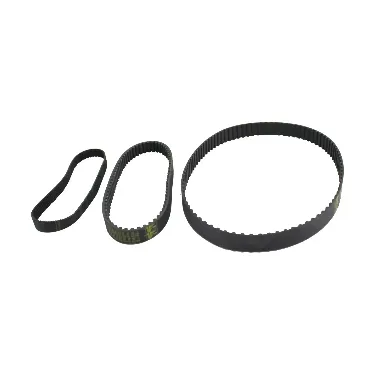Understanding Synchronous Belts and Belt Wheels: Types, Uses, and Benefits
In today’s fast-paced industrial and mechanical environments, efficiency, precision, and reliability are paramount. One key component that ensures smooth and synchronized power transmission is the kembera hevdem and its companion, the synchronous belt wheel. Often used in timing-critical machinery, these components form a belt drive system designed to eliminate slippage, improve performance, and deliver accurate rotational motion between shafts.

This article explores what a synchronous belt is, the various synchronous belt types, and how the synchronous belt wheel works within mechanical systems. We'll also highlight typical applications and considerations when choosing the right components for your needs.
What Is a Synchronous Belt?
A kembera hevdem, also known as a timing belt, is a toothed belt made from rubber, polyurethane, or other reinforced materials. The belt is designed to fit precisely into matching teeth on a synchronous pulley or belt wheel. Unlike conventional V-belts or flat belts, synchronous belts do not slip, which allows for constant speed ratios and accurate transmission of mechanical power.
This precision makes synchronous belts ideal for applications where timing and coordination are crucial—such as in automotive engines, industrial robots, printers, CNC machines, and textile machinery.
How Does a Synchronous Belt Wheel Work?
A synchronous belt wheel (often called a timing pulley or synchronous pulley) is a grooved wheel or gear designed to work in tandem with a synchronous belt. Its grooves match the teeth on the belt, ensuring a positive, slip-free engagement.
When the belt wraps around one or more synchronous belt wheels, the teeth mesh precisely with the grooves, synchronizing rotation between the driving and driven shafts. This setup ensures that both torque and position are transferred with high accuracy, making the system ideal for precision applications.
Benefits of a Synchronous Belt and Belt Wheel System:
No slippage between belt and pulley
High efficiency (up to 98%)
Accurate speed control
Quiet operation
Low maintenance
Long service life with proper alignment
Synchronous Belt Types
Synchronous belts come in several different styles and profiles to suit specific applications. Below are the most common synchronous belt types:
1. Classical Timing Belts (Trapezoidal Tooth Profile)
These are the earliest forms of synchronous belts, with a trapezoidal tooth shape. They are suitable for general-purpose drives.
Common sizes: MXL, XL, L, H, XH, XXH
Applications: Office equipment, sewing machines, light-duty industrial drives
2. High Torque Drive (HTD) Belts
HTD belts use a rounded tooth profile, offering better load distribution and improved strength.
Sizes: 3M, 5M, 8M, 14M, 20M
Applications: Robotics, CNC machinery, and heavy-duty applications
3. STS (Super Torque Synchronous) Belts
An advanced design that further improves power transmission and load carrying. It combines the strength of HTD with finer tooth engagement.
Applications: Servo motor systems, automation equipment
4. Double-Sided Synchronous Belts
These belts have teeth on both sides, allowing power transmission in two directions or between multiple shafts.
Applications: Complex machinery, packaging equipment
5. Polyurethane Synchronous Belts
These belts offer excellent chemical resistance, wear resistance, and dimensional stability.
Applications: Cleanroom environments, food processing, pharmaceutical equipment
Each of these synchronous belt types can be paired with a compatible synchronous belt wheel to create an efficient and reliable power transmission system.
Materials Used in Synchronous Belts and Wheels
Synchronous Belts:
Rubber (Neoprene): Reinforced with fiberglass cords for strength and flexibility.
Polyurethane (PU): Offers high wear resistance and is suitable for clean environments.
Kevlar/Steel reinforcement: Used for added tensile strength in heavy-duty applications.
Synchronous Belt Wheels:
Aluminum: Lightweight and corrosion-resistant.
Steel: Offers high strength and is suitable for heavy loads.
Plastic or composite: Used in light-duty or cost-sensitive applications.
The choice of material impacts the belt’s durability, flexibility, and suitability for specific conditions like heat, oil, or chemical exposure.
Applications of Synchronous Belt Systems
Synchronous belts and belt wheels are used across multiple industries:
Automotive: Camshaft timing belts
Industrial automation: Conveyor systems, robotics, and 3D printers
Textile: Synchronized movements in weaving and spinning machines
Packaging: High-speed packaging machines
Office equipment: Printers, copiers, and scanners
Medical devices: Precision movement in imaging equipment
Their versatility and ability to provide consistent and accurate motion make them indispensable in today’s technology-driven world.
Advantages Over Traditional Belt Systems
When comparing synchronous belts to flat or V-belts, the advantages are clear:
|
Feature |
Synchronous Belt |
V-Belt |
Flat Belt |
|
Slippage |
None |
Some |
High |
|
Efficiency |
Very High (98%) |
Moderate (92–95%) |
Moderate (90%) |
|
Maintenance |
Low |
Moderate |
High |
|
Positioning Accuracy |
Excellent |
Poor |
Poor |
|
Noise Level |
Low |
Medium |
Medium |
Synchronous Belts and Belt Wheels FAQs
Q1: Can a synchronous belt be used for high-speed applications?
A: Yes. Many synchronous belt types, such as HTD and STS, are designed to handle high-speed and high-load scenarios efficiently.
Q2: How do I know which synchronous belt type I need?
A: Consider the application’s load, speed, environmental conditions, and precision requirements. You may consult a manufacturer or supplier for recommendations based on your specifications.
Q3: Are synchronous belts easy to install?
A: Yes, they are relatively easy to install, but proper tensioning and alignment are critical for long life and smooth operation.
Q4: What causes a synchronous belt to fail?
A: Common causes include misalignment, excessive tension, contamination (oil or debris), and overloading. Regular maintenance can help prevent premature failure.
Q5: Can synchronous belt wheels be customized?
A: Absolutely. Manufacturers offer custom pulleys in terms of diameter, width, tooth profile, and material based on your application’s needs.
Whether you're optimizing a production line, building precision machinery, or upgrading automotive components, using the right kembera hevdem and synchronous belt wheel is key to achieving consistent and accurate performance. With various synchronous belt types available, it's essential to understand your application requirements and consult reliable manufacturers or suppliers to select the best solution.








